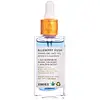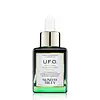What's inside
What's inside
 Key Ingredients
Key Ingredients

 Benefits
Benefits

 Concerns
Concerns

 Ingredients Side-by-side
Ingredients Side-by-side

Caprylic/Capric Triglyceride
MaskingCannabis Sativa Seed Oil
EmollientAdansonia Digitata Oil
EmollientMelia Azadirachta Leaf Extract
Skin ConditioningMelia Azadirachta Flower Extract
Skin ConditioningCorallina Officinalis Extract
Skin ConditioningCoccinia Indica Fruit Extract
Skin ConditioningSolanum Melongena Fruit Extract
Skin ConditioningOcimum Sanctum Leaf Extract
Skin ConditioningOcimum Basilicum Flower/Leaf Extract
TonicCurcuma Longa Root Extract
MaskingVaccinium Myrtillus Seed Oil 100%
Skin ConditioningMelaleuca Alternifolia Leaf Oil
AntioxidantTocopherol
AntioxidantAscorbic Acid
AntioxidantCitric Acid
BufferingCollagen
MoisturisingLactic Acid
BufferingSalicylic Acid
MaskingCaprylic/Capric Triglyceride, Cannabis Sativa Seed Oil, Adansonia Digitata Oil, Melia Azadirachta Leaf Extract, Melia Azadirachta Flower Extract, Corallina Officinalis Extract, Coccinia Indica Fruit Extract, Solanum Melongena Fruit Extract, Ocimum Sanctum Leaf Extract, Ocimum Basilicum Flower/Leaf Extract, Curcuma Longa Root Extract, Vaccinium Myrtillus Seed Oil 100%, Melaleuca Alternifolia Leaf Oil, Tocopherol, Ascorbic Acid, Citric Acid, Collagen, Lactic Acid, Salicylic Acid
Silybum Marianum Seed Oil
Skin ConditioningNigella Sativa Seed Oil
EmollientCucumis Sativus Seed Oil
EmollientPunica Granatum Seed Oil
EmollientDiisopropyl Sebacate
EmollientVaccinium Macrocarpon Seed Oil
Skin ConditioningDimethyl Isosorbide
SolventLinum Usitatissimum Seed Oil
PerfumingCaprylic/Capric Triglyceride
MaskingGlycyrrhiza Glabra Root Extract
BleachingPrunus Armeniaca Kernel Oil
MaskingHexylresorcinol
AntimicrobialEthyl Linoleate
EmollientMelia Azadirachta Leaf Extract
Skin ConditioningChamomilla Recutita Flower Oil
MaskingCitrus Aurantium Amara Flower Oil
MaskingMelia Azadirachta Flower Extract
Skin ConditioningHelianthus Annuus Seed Oil
Emollient4-Terpineol
MaskingSimmondsia Chinensis Seed Oil
EmollientCoccinia Indica Fruit Extract
Skin ConditioningSolanum Melongena Fruit Extract
Skin ConditioningAmber Powder
Curcuma Longa Root Extract
MaskingCurcuma Longa Leaf Extract
Skin ConditioningOcimum Sanctum Leaf Extract
Skin ConditioningAloe Barbadensis Flower Extract
EmollientCorallina Officinalis Extract
Skin ConditioningRosmarinus Officinalis Leaf Extract
AntimicrobialMoringa Oleifera Seed Oil
EmollientTocopherol
AntioxidantCitrus Paradisi Peel Oil
MaskingOcimum Basilicum Flower/Leaf Extract
TonicSilybum Marianum Seed Oil, Nigella Sativa Seed Oil, Cucumis Sativus Seed Oil, Punica Granatum Seed Oil, Diisopropyl Sebacate, Vaccinium Macrocarpon Seed Oil, Dimethyl Isosorbide, Linum Usitatissimum Seed Oil, Caprylic/Capric Triglyceride, Glycyrrhiza Glabra Root Extract, Prunus Armeniaca Kernel Oil, Hexylresorcinol, Ethyl Linoleate, Melia Azadirachta Leaf Extract, Chamomilla Recutita Flower Oil, Citrus Aurantium Amara Flower Oil, Melia Azadirachta Flower Extract, Helianthus Annuus Seed Oil, 4-Terpineol, Simmondsia Chinensis Seed Oil, Coccinia Indica Fruit Extract, Solanum Melongena Fruit Extract, Amber Powder, Curcuma Longa Root Extract, Curcuma Longa Leaf Extract, Ocimum Sanctum Leaf Extract, Aloe Barbadensis Flower Extract, Corallina Officinalis Extract, Rosmarinus Officinalis Leaf Extract, Moringa Oleifera Seed Oil, Tocopherol, Citrus Paradisi Peel Oil, Ocimum Basilicum Flower/Leaf Extract
Ingredients Explained
These ingredients are found in both products.
Ingredients higher up in an ingredient list are typically present in a larger amount.
This ingredient is an emollient, solvent, and texture enhancer. It is considered a skin-softener by helping the skin prevent moisture loss.
It helps thicken a product's formula and makes it easier to spread by dissolving clumping compounds.
Caprylic Triglyceride is made by combining glycerin with coconut oil, forming a clear liquid.
While there is an assumption Caprylic Triglyceride can clog pores due to it being derived from coconut oil, there is no research supporting this.
Learn more about Caprylic/Capric TriglycerideCoccinia Indica Fruit Extract is also known as Ivy Gourd Fruit Extract. It has skin conditioning properties.
Corallina Officinalis Extract is from the red seaweed, Corallina Officinalis. This seaweed is found all over the world but is most common in the rocky shores of Great Britain and Ireland.
Corallina Officinalis Extract contains antioxidant and emollient properties.
Extracted polysaccharides, galactose and xylose, in red algae showed antioxidant activity. Antioxidants help with anti-aging by neutralizing free-radical molecules. Free-radical molecules may damage your skin cells and DNA. Galactose is also a PHA.
Corallina Officinalis is structurally similar to coral due to its high calcium content.
Learn more about Corallina Officinalis ExtractCurcuma Longa Root Extract is from the spice, turmeric. Besides being a healthy and delicious spice, turmeric also has plenty of skincare benefits. It has anti-inflammatory, antioxidant, and anti-microbial properties.
Turmeric contains curcumin, an antioxidant. Antioxidants help neutralize unstable free-radical molecules. Free-radical molecules may damage your skin's cells and DNA. Curcumin may help with anti-aging.
Curcumin also has anti-inflammatory properties and can help soothe skin and reduce irritation. On top of that, curcumin has been shown to help prevent hyperpigmentation from sun damage.
The anti-microbial property of turmeric can make it effective in treating acne. This property has also been shown to help regulate the production of sebum.
Learn more about Curcuma Longa Root ExtractMelia Azadirachta Flower Extract is from the Neem tree. Neem trees originate from India.
Melia Azadirachta Flower Extract contains antioxidants. Antioxidants help fight free-radicals. Free-radicals are molecules that may damage your skin cells, such as pollution.
The flowers of this tree are lilac colored.
Learn more about Melia Azadirachta Flower ExtractMelia Azadirachta Leaf Extract is extract from the neem plant.
The leaves of this tree contain flavonoids and polyphenols. These two compounds are antioxidants, anti-inflammatory, and antibacterial. Further research is needed as to their effects when applied on skin.
We don't have a description for Ocimum Basilicum Flower/Leaf Extract yet.
Ocimum Sanctum Leaf Extract comes from the Holy Basil plant. Holy Basil is native to India.
Holy Basil is rich in antioxidants due to its high romarinic acid, ferulic acid, and rutin content. This gives it skin brightening and soothing properties.
While Holy Basil has many claims to help fight acne, more research is needed.
One thing to note is the presence of tannins; tannins are naturally found in nature. However, this compound may be skin-sensitizing.
Learn more about Ocimum Sanctum Leaf ExtractWe don't have a description for Solanum Melongena Fruit Extract yet.
Tocopherol (also known as Vitamin E) is a common antioxidant used to help protect the skin from free-radicals and strengthen the skin barrier. It's also fat soluble - this means our skin is great at absorbing it.
Vitamin E also helps keep your natural skin lipids healthy. Your lipid skin barrier naturally consists of lipids, ceramides, and fatty acids. Vitamin E offers extra protection for your skin’s lipid barrier, keeping your skin healthy and nourished.
Another benefit is a bit of UV protection. Vitamin E helps reduce the damage caused by UVB rays. (It should not replace your sunscreen). Combining it with Vitamin C can decrease sunburned cells and hyperpigmentation after UV exposure.
You might have noticed Vitamin E + C often paired together. This is because it is great at stabilizing Vitamin C. Using the two together helps increase the effectiveness of both ingredients.
There are often claims that Vitamin E can reduce/prevent scarring, but these claims haven't been confirmed by scientific research.
Learn more about Tocopherol